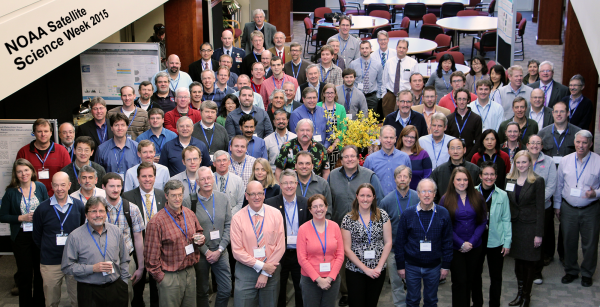2015 NOAA Satellite Science Week
Last week weather satellite product developers and users attended the 2015 NOAA Satellite Science Week at the University Corporation for Atmospheric Research (UCAR) in Boulder, CO. With the launch of the Joint Polar Satellite System (JPSS) in two years and the launch of the Geostationary Operational Environmental Satellite R-Series satellite (GOES-R) just a year away, the push for improved and innovative methods to improve weather forecasts continues.
Similar to last year’s meeting, the week showcased research on both geostationary and polar products. Tim Schmit, a NOAA Advanced Satellite Products Branch (ASPB) scientist stationed at the Cooperative Institute for Meteorological Satellite Studies (CIMSS), added that the meeting “allowed for a unique gathering between many satellite product producers and consumers.”
The interactions between developers and users can prove critical. Developers receive feedback on their products, which allows them to modify their work or conduct further research to suit the needs of the users, while users learn more about what to expect with future products, which allows them to prepare for their eventual use in forecasting.
Space Science and Engineering Center (SSEC) Executive Director for Science Wayne Feltz noted that nine CIMSS and five ASPB members attended the satellite science meeting. ASPB scientists gave oral presentations on cloud products, probabilistic nearcasting of severe weather, Arctic climate change observations, and possible scan modes for the GOES-R imager (the Advanced Baseline Imager, or ABI). Through poster presentations CIMSS scientists covered a variety of topics including satellite-derived overshooting tops, sea ice thickness, tropical cyclone intensity, and best practices for transitioning research to operations.
In addition to the presentations, Feltz explained that three independent review boards met in closed sessions during the week. Based on the discussions at the meeting, these three boards, the NWS Operational Advisory Team, the Independent Advisory Committee, and the NOAA Science and Demonstration Executive Board, provided recommendations on research directions for the upcoming year.
One major new development concerned GOES-R. Schmit relayed the recent announcement that after a year of post-launch testing GOES-R is now scheduled to go into operations, rather than on-orbit storage. In other words, much of the research and many of the products being discussed could make positive forecast impacts sooner than planned.
As an example, a poster presented by Michael Eckert of the Federal Aviation Administration (FAA) highlighted a satellite product used for decision support. This product was developed through a collaboration of ASPB and CIMSS scientists, led by ASPB’s Mike Pavolonis. According to Schmit, the “poster noted that there was over $800K of aircraft savings in just two cases when the GOES-R fog and low stratus algorithm was applied to current GOES information.” The product successfully helped airlines avoid unnecessary diversions and ground stops. This product will be improved when it can employ the GOES-R ABI data with finer resolutions.
Due to its location in Colorado, this year’s meeting offered a new highlight: the opportunity for attendees to visit Lockheed-Martin to see the GOES-R spacecraft and to Ball Aerospace to see the JPSS-1 spacecraft.
Commenting on the week’s discussions, Schmit noted that “while work remains, much work has been done both with existing satellite resources and in preparation for new ones, such as GOES-R.”
by Leanne Avila

